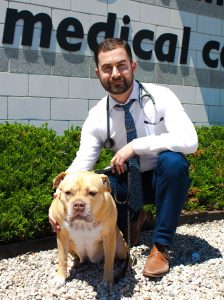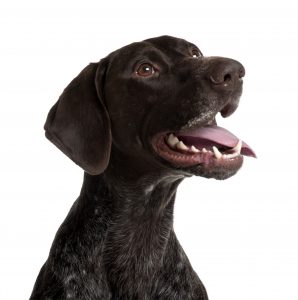-
Adopt
-
Veterinary Care
Services
Client Information
- What to Expect – Angell Boston
- Client Rights and Responsibilities
- Payments / Financial Assistance
- Pharmacy
- Client Policies
- Our Doctors
- Grief Support / Counseling
- Directions and Parking
- Helpful “How-to” Pet Care
Online Payments
Emergency: Boston
Emergency: Waltham
Poison Control Hotline
-
Programs & Resources
- Careers
-
Donate Now
 By Rob Daniel, DVM, DACVIM (Neurology)
By Rob Daniel, DVM, DACVIM (Neurology)
angell.org/neurology
neurology@angell.org
617-541-5038
Cranial nerve V, the trigeminal nerve, is one of a symmetric pair that begins in the pons, travels through one of the cerebellar peduncles, through the canal within the petrosal portion of the temporal bone through the trigeminal ganglion to join the mandibular nerve. The mandibular nerve exits the oval foramen and supplies the muscles of mastication (the masseter, temporalis, pterygoid, rostral digastricus and mylohyoideus muscles)
Unilateral loss of motor function is appreciated by masticatory muscle atrophy. An open mouth secondary to dropped mandibles implicates bilateral trigeminal neuropathy, as a unilateral neuropathy will not be sufficient to show a persistently ‘dropped jaw.’ Drooling and dysphagia often accompany this clinical sign.
The most common cause of acute-onset, inability to close the mouth (‘dropped-jaw’) is trigeminal neuropathy (i.e. trigeminal neuritis), a disease process that is idiopathic, bilateral, non-suppurative and affects all motor branches of the trigeminal nerve. This motor dysfunction is occasionally accompanied by a Horner’s Syndrome (sympathetic paralysis to the head) and/or sensory disturbances to particular regions of the head.
Differential diagnosis for a sudden onset inability to close the mouth is neoplasia (mononuclear neoplasia, such as lymphoma ormultiple myeloma), infectious polyradiculoneuritis and less commonly, head trauma and meningoencephalomyelitis (involving bilateral motor nuclei of the trigeminal nerve). It is important to consider rabies in the unvaccinated dog that presents with a dropped jaw, a manifestation of the generalized lower motor neuron dysfunction present with this disease.
 Preliminary laboratory – screening should include a complete blood count, serum biochemistry, urinalysis, and thyroid panel. Examination findings that implicate bilateral trigeminal neuropathy are enough to make trigeminal neuropathy a top differential, although higher tier testing (brain MRI and cerebrospinal fluid) can help in clarifying the diagnosis. The cerebrospinal fluid analysis can be particularly specific for round cell neoplasia and in cases of trigeminal neuropathy, a mononuclear pleocytosis with or without elevated protein is the most common abnormality. Common structural abnormalities on MRI with trigeminal neuropathy are T2-weighted hyperintensity within the trigeminal nerve, as well as T1-weighted contrast enhancement. Atrophy (neurogenic atrophy, if early in the course of the disease) of the muscles of mastication may be seen on MRI, along with effusion in the middle ears secondary to the persistent closure of the auditory tube (denervation atrophy to the tensor veli palatini muscles).
Preliminary laboratory – screening should include a complete blood count, serum biochemistry, urinalysis, and thyroid panel. Examination findings that implicate bilateral trigeminal neuropathy are enough to make trigeminal neuropathy a top differential, although higher tier testing (brain MRI and cerebrospinal fluid) can help in clarifying the diagnosis. The cerebrospinal fluid analysis can be particularly specific for round cell neoplasia and in cases of trigeminal neuropathy, a mononuclear pleocytosis with or without elevated protein is the most common abnormality. Common structural abnormalities on MRI with trigeminal neuropathy are T2-weighted hyperintensity within the trigeminal nerve, as well as T1-weighted contrast enhancement. Atrophy (neurogenic atrophy, if early in the course of the disease) of the muscles of mastication may be seen on MRI, along with effusion in the middle ears secondary to the persistent closure of the auditory tube (denervation atrophy to the tensor veli palatini muscles).
No definitive treatment has shown to be of any benefit with trigeminal neuropathy The most important aspect in the management of these patients is nursing care, specifically ensuring adequate hydration/caloric intake and performing frequent physical therapy. Esophagostomy or gastrostomy tubes should be considered early in the course of the disease if the patient is unable to meet caloric demands through assisted, non-forceful feeding methods.
Most dogs affected with trigeminal neuropathy recover within a month of onset of clinical signs. Overall, the ultimate prognosis for this disease process can be good.
References:
Handbook of Veterinary Neurology 5th Edition. Michael Lorenz, Joan R. Coates and Marc Kent. Elsevier, Saunders 2011
Veterinary Neuroanatomy and Clinical Neurology; 4th Edition. De La hunta, Glass and Kent. Elsevier Saunders, 2015.
Trigeminal Neuropathy in Dogs: as retrospective study of 29 cases (1991-2000). J Am Anim Hosp Assoc. 2002 May-Jun; 38(3): 262-70.
Denervation of the Tensor Veli Palatini Muscle and Effusion in the Tympanic Cavity. Kent M, Talarico LR, Glass EN, de Lahunta A, Plat SR and Haley AC. J Am Anim Hosp Assoc 2015 Nov-Dec; 51(6): 424-8.